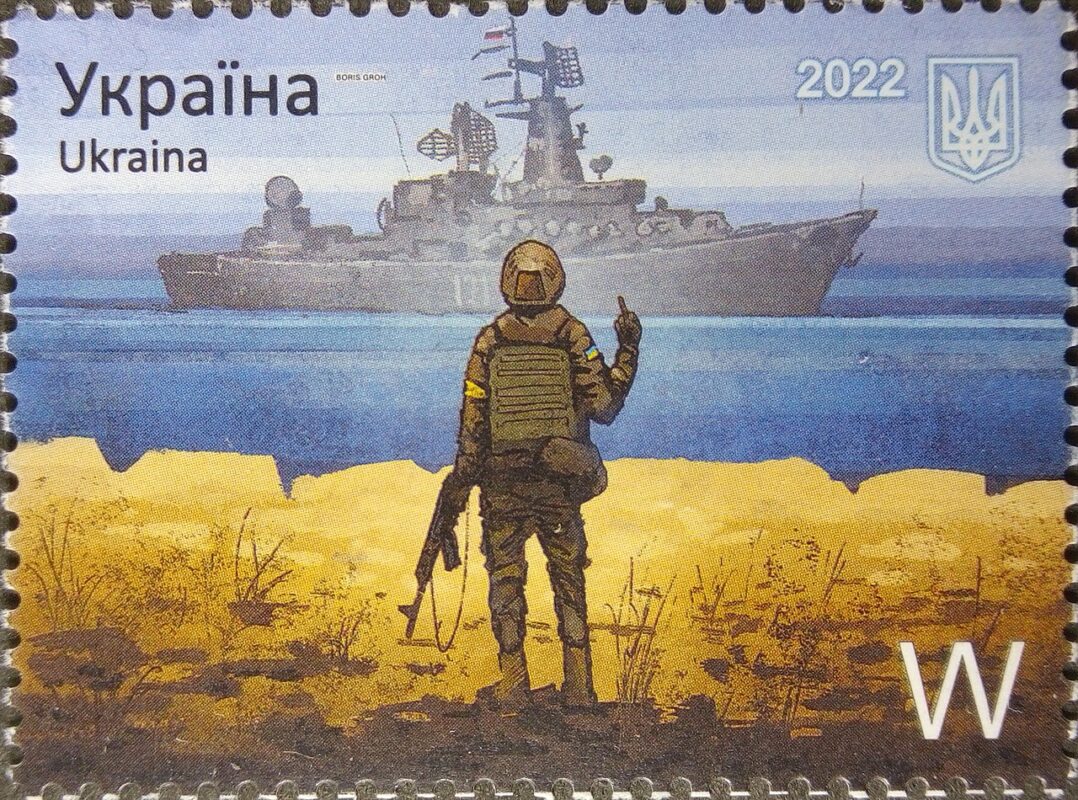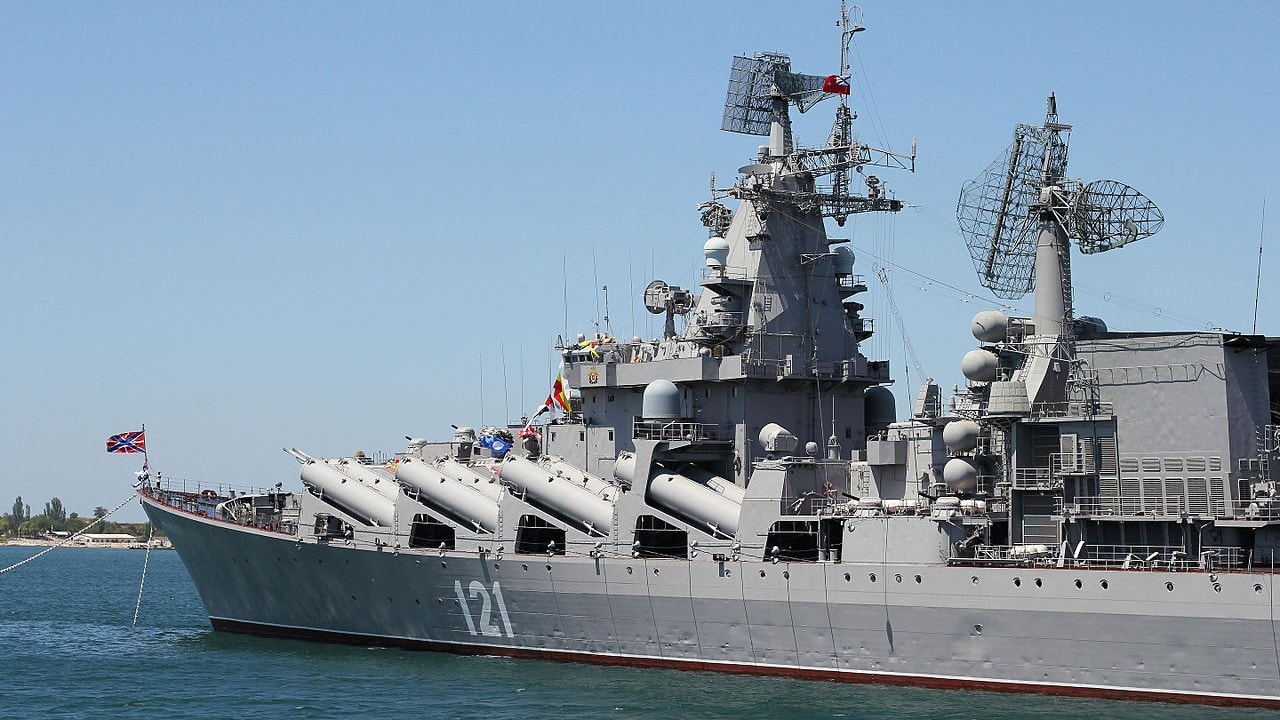The Curse of Snake Island Claims More Russian Vessels – On April 26, vengeful Furies began circling ominously over Snake Island bringing down from the heavens highly tangible woe upon Russian troops occupying the legendary burial ground of Achilles.
Over the next seven days, air defense systems and electronic warfare apparatuses began exploding on the minuscule Black Sea islet, captured from Ukraine by the Russian Navy on February 24
These bolts from the blue culminated in the obliteration of two Raptor-class patrol boats on May 2nd, apparently dispatched to reinforce the beleaguered Russian garrison.
The small vessels joined the powerful missile cruiser Moskva, leader of the assault on the island, on the floor of the Black Sea.
In fact, Moskva is the third cruiser to meet misfortune after attacking the island, the site of numerous battles, raids, and sinkings over three centuries.
“Russian Warship, go ___ yourself!”
Snake Island (or Zmiinyi in Ukrainian) measures merely one-sixth of a square kilometer, but the tiny landmass jutting 41 meters above sea level has for centuries been valued as a surveillance, navigation and communications outpost. That’s due to its strategic position 20 miles east of the mouth of the Danube River and 80 miles south of the Ukrainian port of Odessa.
Control of the island passed back and forth between Moscow, Istanbul, Bucharest and Kyiv—and changed hands yet again on the opening day of Putin’s invasion of Ukraine at the hands of a Russian taskforce led by Black Sea Fleet’s flagship cruiser Moskva (11,490-tons), escorted by the corvette Vassily Bykov and frigate Admiral Essen.
Buzzing by the island at 6 PM, they transmitted a message to the detachment of the Ukrainian border guards on the island, who lacked anti-ship weapons.
“You are in complete isolation and in effective range of our weapons. In case of resistance, you will be destroyed. Think of the children and loved ones who need you, who love you, who are waiting for you to return alive. It will soon be over and you can continue your normal life. Make the right decision, stay alive. Inform us on channel 16 about your intention to cooperate.”
Guardsman Roman Hrybov, a former Ukrainian marine and disco DJ from Cherkassy, famously messaged back “Russian warship, go f*ck yourself!”
The vessels raked the snow-covered island with their guns. The Moskva’s big twin-gun turret thumped out 130-millimeter shells while her 30-millimeter Gatling cannons spat rapid-fire fusillades, audible in an abbreviated cellphone video sent by the garrison.
For good measure, a Su-24 bomber swooped in and cratered the outpost with bombs.
Satellite photos show the barrage damaged or destroyed the lighthouse, communication towers, and red-roofed housing. Finally, after the guardsmen allegedly repulsed two Russian forays, Russian troops secured the island at 10 PM and seized the civilian rescue vessel, Sapphire.
Kyiv claimed the detachment of 13 Ukrainian border guards were all killed, while Moscow reported capturing 82 Ukrainian troops.
A few days later, Kyiv conceded some of the guardsmen indeed survived. Finally, on March 24, nineteen Ukrainians captured there, including Hrybov, were repatriated in exchange for 11 Russian sailors. Hrybov’s defiant statement had become a rallying cry for Ukrainian resistance, immortalized in a postage stamp issued on April 12.

Meanwhile, Russia deployed personnel with electronic warfare systems, sensors, and communications equipment to the island, some ferried over by Ropucha-class tank-landing ships. The garrison could serve as a listening post and logistical base adjacent to the Ukrainian port of Odesa—one of Moscow’s chief objectives—and Romania, an important base for NATO fighters and missile defense systems.
To defend against air attack, a battery of Strela-10 (SA-13 Gopher) tracked vehicles armed with short-range heat-seeking missiles was deployed, and a Repellant-1 system: a 20-ton 6×6 truck mounting a retractable jammer that can disrupt remote-control signals used to control drones from up to 30 kilometers away.
The Curse of Snake Island
The three Russian warships that bombarded the island were soon seemingly beset by misfortunes. The Vassily Bykov was supposedly peppered by Ukrainian land-based rocket artillery while cruising near Odesa on March 7. Then April 3, a Neptune anti-ship missile allegedly damaged Admiral Essen on April 3.
However, neither attack can be confirmed; whether Bykov was attacked, later images show she wasn’t damaged. More indisputable, however, was the fate of the Moskva.
While patrolling a short distance east of Snake Island on April 13, the powerful cruiser built to sink U.S. aircraft carriers with long-range P-500 missiles was struck by two Ukrainian ground-launched Neptune missiles. A fire broke out in Moskva’s deck, likely fed by explosions from her large carrier-killer munitions.
The powerful warship sank the following day while under tow. Her loss was more than an ill omen: with her went the long-range S-300F surface-to-air missiles protecting the Snake Island garrison and nearby warships from high-flying aircraft.
On April 26, Ukraine’s southern military district announced it had destroyed a command post and a Strela-10 vehicle on Snake Island using unspecified means.
Then on April 30, it reported three more Strela-10s were knocked out, a towed ZU-23-2 twin-barrel anti-aircraft gun, and the Repellant-1 counter-drone system strikes allegedly inflicted 42 casualties on the besieged garrison.
Two hours before the ZU-23-2 strike, a Ukrainian TB2 struck a Russian Strela-10 short-range air defense system on Snake Island. https://t.co/rbTvheDN0n pic.twitter.com/nt1D9PvBES
— Rob Lee (@RALee85) May 2, 2022
Imagery confirming at least some of these attacks was released in May, showing the targeting system of a TB2 Bayraktar combat drone engaging the ZU-23-2 cannon a Strela-10 with MAM-C and/or MAM-L laser-guided missiles from 7.2 and 8.3 kilometers away.
Telemetry visible in the bottom right corner of the Bayraktar videos suggests the attacks were launched from 7 and 8.3 kilometers (4.34-5.15 miles) away. The Strela-10’s missiles have a maximum 5 kilometers (3 miles) and max intercept altitude of 11,500 feet, while the Bayraktar’s service ceiling is around 25,000 feet.
Additional strike footage shows an attack on telecommunication equipment and an ammunition dump apparently full of rockets or missiles.
https://twitter.com/RALee85/status/1521631421412036608
The TB2’s UI is also clearly visible in videos released May 2 showing the attack on two Project 3160 Raptor boats, again from a range of 6.6-7 kilometers. The second boat is seen maneuvering evasively at high speed to no avail. The Raptor’s stabilized, electrooptically-guided 14.5-millimeter KPV-T machinegun is only effective against aerial targets out to 2 kilometers.
Russia’s Navy began the war with 17 Raptors. Powered by U.S.-built Caterpillar turbodiesels and Rolls-Royce waterjets, they can attain speeds of 48 knots (55 mph) and have a typical operating radius of 100 miles. They’re used for coastal patrols, rescue, anti-sabotage defense, and high-speed troop transport with a capacity for 20 personnel. Besides the two destroyed at Snake Island, a third Raptor was damaged near Mariupol on March 22 by an AT-4 anti-tank missile.
The Repellant-1 system on the island, however, should have been useable. Moscow indeed claims to have shot down three Bayraktars around Snake Island. That may mean the TB2 strikes were paid for in attrition of this valuable asset, but Russian anti-air claims are notoriously exaggerated, with more Bayraktar reported destroyed than Ukraine ever had.
It’s unclear how effective Russian forces on Snake Island remain. The Russian Navy will have to choose between doubling down on a base it clearly finds difficult to defend or withdrawing. Should the latter occur, Ukraine too will face the dilemma of whether to reestablish an outpost so vulnerable to attack, given the island’s small size and lack of concealing terrain. But given the island’s symbolic stature, it seems likely to remain a bone of contention.
At the intersection of empires
According to legend, Snake Island is the burial place of the Greek hero Achilles. After Achilles was famously felled by a blow to his heel, his mother Thetis spirited his body away from its funeral pyre for burial on Leuke (White Island). Thereafter, the island hosted a temple/shrine dedicated to Achilles, tended to Greek priests, as well as the occasional pirate band.
Over a millennia later, on July 14, 1788, Russia’s newly-built Black Sea Fleet fought its first major battle by the island, then known as Fidonisi (“Snake”) after the white serpents infesting it. Despite outnumbering Russian ships of the line 10 to 2, the Turkish fleet withdrew after sustaining significant damage.
In the 19th century, the island changed hands multiple times between Moscow, Istanbul, and finally Bucharest, during which a 12-meter-tall lighthouse was built atop the ruins of Achilles’s shrine.
When Romania joined the Entente alliance in World War I, it used a wireless station on Snake Island for communication with Russia. In May 1917 the Ottoman cruiser Midilli (formerly the German SMS Breslau) destroyed the outpost and its 19th-century lighthouse with her eight 150-millimeter guns and took 11 prisoners.
Seven months later on January 20, 1918, after sinking two British monitors close to Imbros island, Midilli struck five mines and sank, taking 330 onboard with her, leaving only 133-162 survivors (sources differ).
In World War II, the Soviets and Romanians were now adversaries. Thus Russian air and sea forces attacked the island and its radio station, which was defended by a Romanian marine platoon armed with 45-, 76- and 122-millimeter coastal guns and two 37-millimeter anti-aircraft cannons. More effectively, Romanian and German ships laid two dense minefields around the island in the fall of 1942.
That failed to dissuade Soviet cruiser Voroshilov and escorting destroyer Soobrazitelny from plastering the outpost with 242 180- and 130-millimeter shells on December 1, 1942 somehow inflicting remarkably little damage. But while egressing, the Voroshilov struck two mines and was forced to limp back to port for repairs.
Over the next couple of weeks, the Snake Island mine barrages also destroyed two Soviet submarines, the 592-ton Shch-212 and the 208-ton M-31 with loss of 75 crew between them. Finally, in August 1944, Romanian troops abandoned the island, which fell under Soviet control.
Post-war Moscow held the island over Romanian objections, installing radars and navigational beacons. When the Soviet Union dissolved in 1991, the island passed into Kyiv’s control, though in the 2000s Romania revived its legal disputes over the island in the International Court of Justice.
Meanwhile, Ukraine built-up infrastructure on the island, including a helicopter pad, a pier on its northwest corner, a marine research station on the northeastern tip, and the ‘town’ of Bile with a variety of quality-of-life amenities.
Russia is therefore only latest occupier of this islet on the Black Sea at the intersection of several nations. We likely haven’t heard the last of Snake Island and the misfortunes of forces warring for control of it.
Sébastien Roblin writes on the technical, historical, and political aspects of international security and conflict for publications including The National Interest, NBC News, Forbes.com, War is Boring, and 19FortyFive, where he is Defense-in-Depth editor. He holds a Master’s degree from Georgetown University and served with the Peace Corps in China. You can follow his articles on Twitter.

